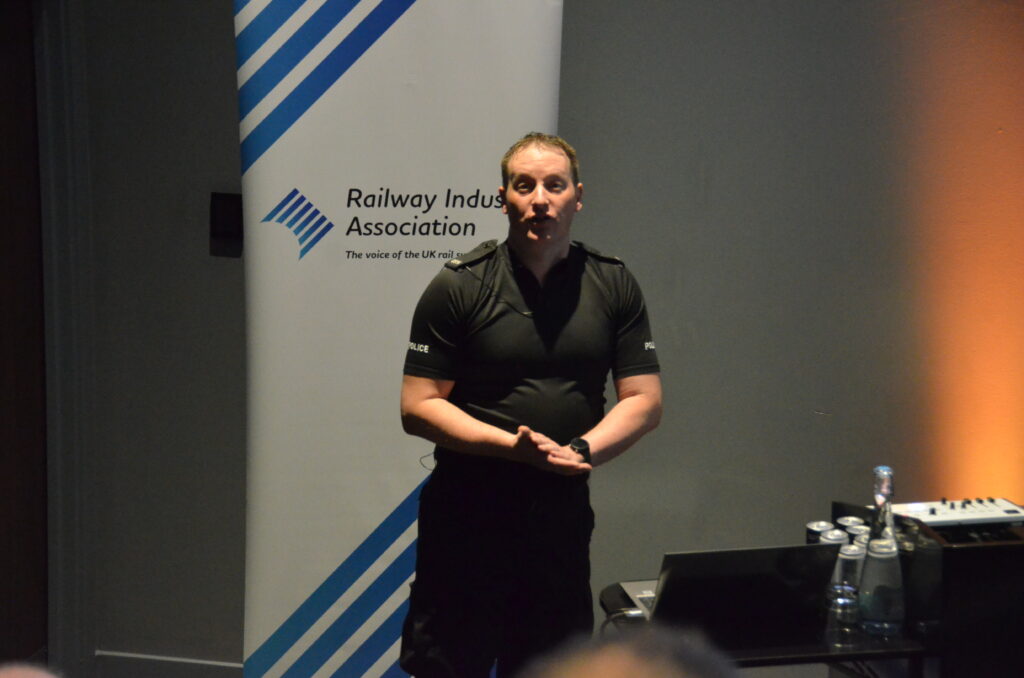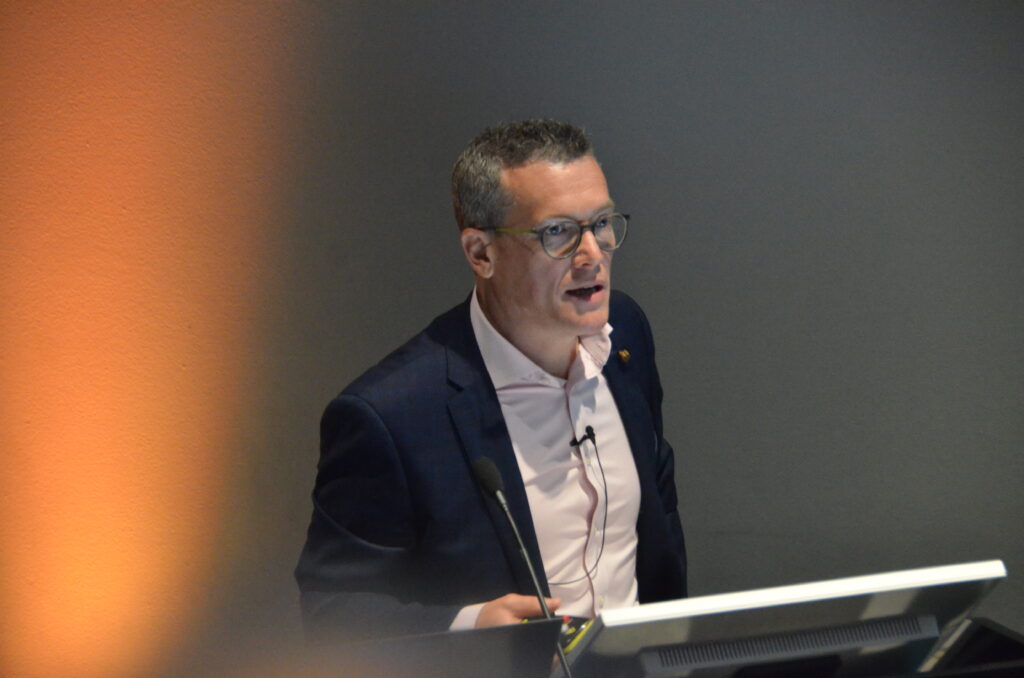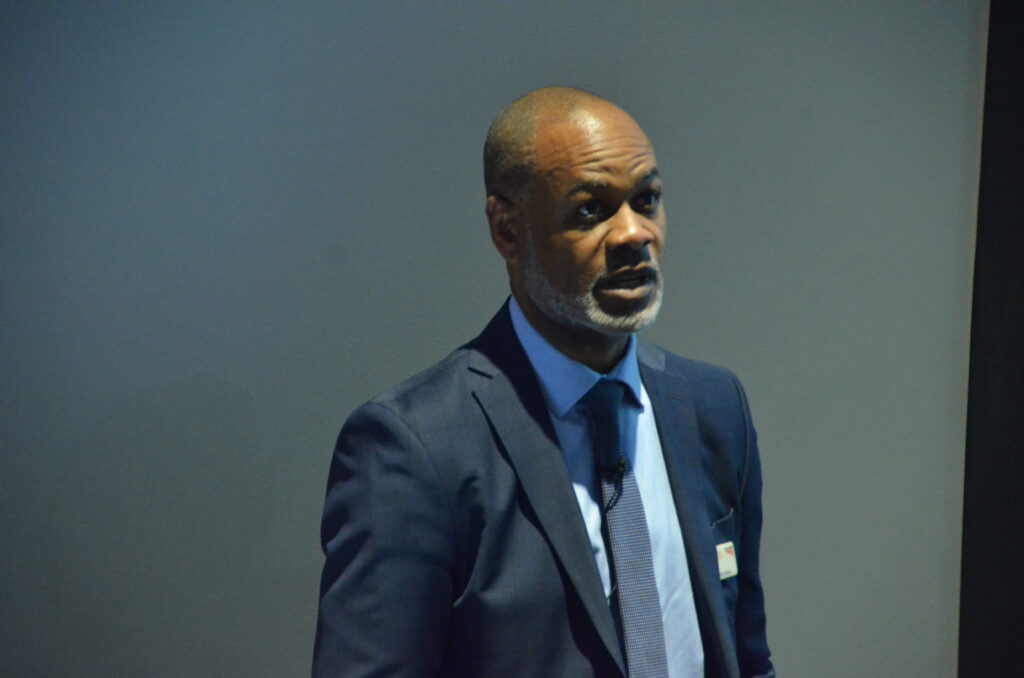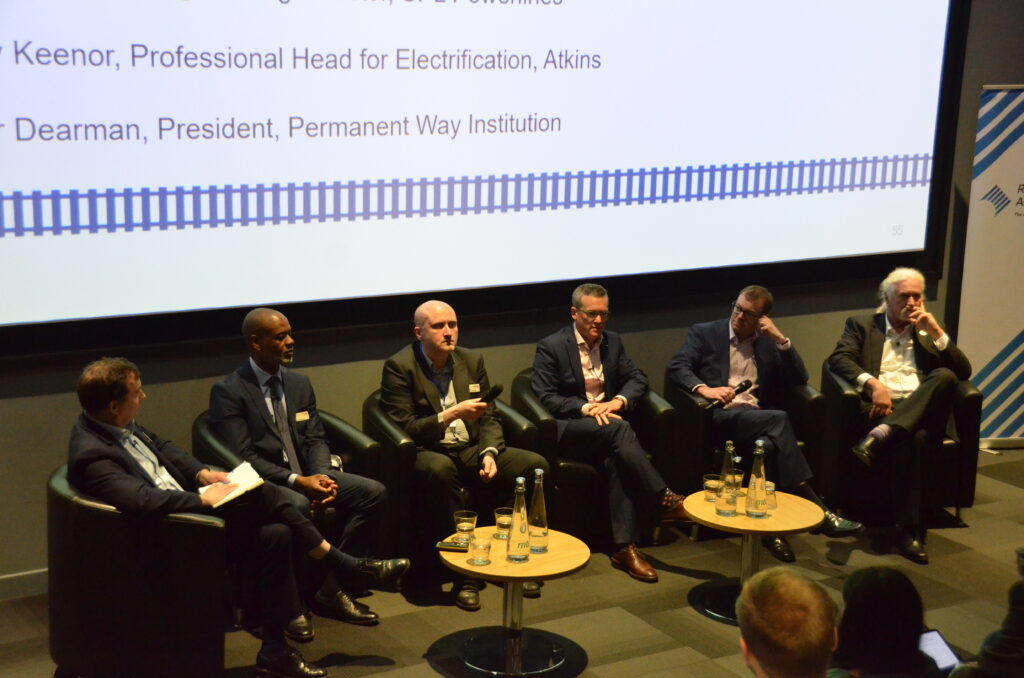Keeping both the public and rail workers safe from railway electrification, innovative ways of doing so, and the pressing need for a rolling programme of electrification in England to meet the government’s decarbonisation target by 2050 were the main themes of a Traction Power Innovation & Safety Showcase, hosted by Network Rail and the Railway Industry Association (RIA) at Coventry’s Manufacturing Technology Centre.
A formal conference on these and other topics ran alongside an exhibition by 16 industry suppliers showing everything from cables to complete overhead systems.
The day’s session started with the focus clearly on safety. Constable Mark Etienne of British Transport Police showed a harrowing video of Harrison Ballantyne’s story – an 11-year-old electrocuted and killed after climbing on a freight wagon in a depot where trains were not moving but the 25kV overhead was still live.
Although fenced, the boy had no trouble climbing over it and into the freight yard to retrieve a lost football. Climbing onto a wagon, he didn’t touch the live cable, but the electricity still arced over to his body, killing him instantly.
The village where Harrison lived had no railway station, and he had seemingly received no education on the dangers of the railway and its electric traction system. Delegates were urged both to support local safety training programmes and to make sure that all fencing is adequate and unclimbable.
The task ahead
Peter Dearman, immediate past-president of the Permanent Way Institute, a former head of electrification at Network Rail and consultant with both Systra and Atkins, was the next speaker. He was invited by conference host David Clarke, RIA’s technical director, to make some personal observations on the need for electrification and how to deliver safely.

“Climate change is a reality,” he stated. “We are left, as humankind, with no option but to stop using fossil fuels. There are other technologies which vie for attention in looking towards an electric future – hydrogen, batteries – but none of them are going to fulfil the promise that main line electrification needs to be fulfilled.
“We’ve got a huge amount to do, but we’re not going to do any of it unless we get costs under control. Our recent history of delivery is not terrifically encouraging. However you cut it, CP5 was a disaster in terms of our position and respect that we have throughout government, and treasury particularly. They don’t trust us, we can’t deliver anything on time, we can’t deliver to scope, and we certainly can’t deliver it for anything like the costs that we estimate. That’s our problem.”
Peter continued by pointing out that the problem of having to electrify 13,000 single track kilometres (stk) by 2050 wasn’t just down to the railway industry, others have to be involved as well – particularly the National Grid, which will be undertaking major changes to its power distribution network.
“If they don’t know what we want, they’re not going to build it for us,” Peter stated. “They’ve got to do the job on the grid for your house, the factories around the country, and the hospitals. They can’t wait for us to dither around making up our minds what we want to do, they’re going to do it. If that means there’s no traction power available, then there won’t be traction power available. So, we need to get our marker down. We need a grid connection strategy.”
Towards the end of his talk, Peter tackled the topic of safety. “I’m not going to take away from the message that Mark shared with us just before this presentation,” he said. “Sitting in the audience with us is a gentleman who suffered horrific injuries 40 years ago because of contact with 25kV.
“Bryant was an overhead linesman, an overhead line supervisor, one of the most experienced – it’s those guys who are the most at risk. We need to get that put right. We need to do that through upskilling the people – you can’t technology your way out of this problem. There is no technology which will make contact with 25kV safe, it’s people and behaviours that we need to sort out.”
New designs
Phil Doughty, Network Rail’s chief mechanical and electrical engineer, continued Peter’s theme. Much work has been done to drive down unit costs since a “not great CP5”.
On overhead line routes, work is taking place on a rationalised design for ‘classic’ electrification, electrical performance testing, bridge parapets and clearances, and insulated pantograph horns. A new master-series catenary design, featuring 95-metre spans, had been defined only the day before.
A new standard for third-rail conductor rail design has also been finalised.
Safety protocols such as test before touch are also being rolled out, as is the local securing of DC networks. ‘Safety by Design’ is the latest programme to improve the railway’s electrical safety culture.

Simon Skinner, engineering director of SPL Powerlines, asked the key question – is Network Rail’s traction decarbonisation strategy affordable? “Probably not,” was his answer.
To achieve the level of electrification needed, a massive ramp-up in work is anticipated from 2028. This is a concern, as the last time that rail electrification experienced such a jump in workload, it failed comprehensively due to skill shortages. A steady ramp up towards a rolling programme is needed to sustain skills and support continuous improvement and thus lower costs.
Technology will help, as will discipline integration and new ways of working, with electrification teams working with colleagues in every discipline from track to signalling and vegetation control to make the programme happen, but the programme will need to run smoothly, with fewer interventions, to drive down the cost per stk.
Building Information Modelling (BIM) will become a “must do, not a nice to have”, as will a common data environment and other advances in project management.
One piece of advice Simon gave was “don’t innovate throughout the project”. Freeze technology before the project starts, as trying to introduce innovations part-way through is as disruptive as any other programme change, and it was these types of ‘moving goalposts’ that, in part, sank the Great Western electrification programme.
Robert Ampomah, Network Rail’s chief technology officer, rounded off the morning presentations. He also admitted that the industry was “quite a bit behind the curve” in electrifying a railway that has to be zero-carbon by 2045 in Scotland and 2050 in England and Wales.
He revisited the lasting problems of Great Western electrification, which was estimated to cost £1 billion in 2009 but actually cost over £5 billion, despite the programme being truncated. “As an industry, we must be much more efficient and deliver when we say we are going to deliver,” he added.
However, he stressed innovative work was being done. Recent improvements in what he called the Cost Efficient Electrification Project phase 1, which includes the reduction in acceptable clearances and the resultant decrease in the number of structures that need to be rebuilt, has so far resulted in savings in the region of £200 million in Scotland, £29 million in the East Midlands, and £144 million on the Transpennine Route Upgrade.
Further work is being carried out, and Robert listed some of them: in-line neutral sections, overhead line equipment (OLE) dynamic modelling, a new Reconfigurable Autotransformer System (RATS) to digitalise classic electrification, a new conductor-rail management system, renewable power generation, and DC trackside energy storage systems. All to be deployed soon, these improvements should result in a greener railway that is safer, sustainable, and achievable at lower cost.
Ask the panel

There then followed a panel session including all of the morning’s speakers with the addition of Martin O’Connor (head of OLE and conductor rail, Network Rail) and Garry Keenor (professional head for electrification, Atkins).
Chaired by David Clarke, the panel fielded various questions, including one from Dave Barnes, Network Rail Southern Region, on DC switchgear innovations. His question was met by a small cheer from third-rail supporters who seemed to be feeling a bit overwhelmed by OLE engineers. The answer? Martin O’Connor said that an innovative design is being worked on that will virtually eliminate risks in the DC railway. “It’s a very exciting time on the DC system,” Martin enthused.
Another questioner asked about the importance of Artificial Intelligence (AI) in the coming years. “There must be huge opportunities,” David Clarke commented, before handing the question over to the panel.
“AI can strengthen the design process,” Garry Keenor commented. He then reminded the audience that money spent up-front on design could save more than it cost when transferred to the live project. “Spend £1 on design and save £100 overall” was how he put it.
Robert Ampomah spoke to dispel some concerns. “AI doesn’t deskill our people,” he said. “We need good engineers to get the most out of AI.”
Other questions were asked on partial electrification infilled by other technologies, the technology road map being developed by Network Rail and RSSB (“Question everything,” Garry Keenor) and alliancing (“Work together to overcome problems,” Peter Dearman).
Exhibition and workshops
A lunchtime break followed, giving delegates plenty of time to visit exhibitors’ stands and network with colleagues. All of the stands were busy, and many delegates could be seen deep in conversation with individuals and small groups.
Several workshops ran after the break. One was presented by Bryant Latham, a long-time railwayman and overhead linesman. Bryant was the gentleman that Peter Dearman had referred to earlier, who was hit by 25kV while working to clear a downed line 40 years ago. His description of his accident, how it happened, and the mental trauma he suffered in addition to his physical injuries was stark and graphic.
Bryant now visits companies involved with overhead line work to draw attention to the dangers and the need for constant vigilance.
This ‘Electrical Safety Step-Up’ is a 30-minute facilitated session aimed at practitioners that work on and around traction power electricity. Part of the wider Culture & Industry Approach strategy to address cultural change and recommendations from recent electrical safety incidents, the Step Up has been shaped from feedback received by industry representatives to focus on why everyone must follow process, the consequences if they don’t, and what good looks like (relating to behaviours).
Bryant stressed that improving the industry’s electrical safety culture is the foundation for embedding changes to ways of working and process.

Delivering electrical safety
Kamini Edgley, director of engineering & asset management for Network Rail’s North West and Central region, gave the first presentation after the workshop sessions. She returned to Peter Dearman’s theme at the start of the conference, stressing the importance of planning ahead and making sure that sufficient traction power is available. “New trains are coming,” she said, “but Acton Lane is already at capacity for traction power.”
Over the next 25 years, the answer will be the renewal of a large part of the NW&C infrastructure, enhanced capacity at pinch-points such as Crewe, and further autotransformer conversions. She also introduced her plans for the Pantograph Damage Assessment Tool (PANDAS), developed by the Northumberland-based technical engineering company Transmission Dynamics to detect faults in overhead electric lines used in mass public transport networks. A wireless system, it uses miniature accelerometers clamped on the pantograph head to detect changes in the condition of the overhead wires above.
Two allied safety programmes featured heavily in Kamini’s presentations. Safer Isolations (DC network) and Remote Securing (AC infrastructure) are both designed to make isolating electrical equipment easier, safer, and more certain. No longer will workers need to go out on the line to isolate equipment and fit short-circuit safety links – in future it will all be done remotely using pre-installed equipment.
Phil Doughty returned to the lectern for the last session of the day and a quick look at Network Rail’s plans for Control Period 7 (2024-2029). An operations, maintenance, and renewals budget of £44 billion for England and Wales and £4.6 billion for Scotland will include an electrification and power element of around £2 billion.
Electrical safety devices will total around £361 million, made up of £296 million on the safer, faster isolations programme that Kamini had described, and £65 million for process improvements. The rest will pay for:
- OLE – partial refurbishment, contact/catenary wire rewire, heavy maintenance.
- Conductor rail renewal – increased from CP6 levels.
- AC Traction – renewal and refurbishment of 25kV circuit breakers.
- DC Traction – switchgear renewal and refurbishment.
- Signalling power cable renewal – similar volumes to CP6.
Phil also conducted a survey of delegates to get their views on the priorities for the industry. Some of the answers were surprising (Is the industry ready for CP7? No – 63%). Others were less so (What is the key engineering barrier preventing low-cost electrification? Top answers: risk-averse behaviours and nothing – the challenge is not an engineering one, both 30% of responses).
Discussion on the responses brought the day’s session to a close. Delegates all seemed to feel it had been a day well spent and look forward to another, similar session in 2024.

List of exhibitors
- Brush
- Cable Services
- Cembre
- Ciras
- EA Technology
- Horizon Utility Supplies
- Meteor Power
- Pace Networks
- Sella Controls
- Siemens Mobility
- The PWI
- Tratos
- Trough-Tec Systems
- Unipart Rail
- University of Nottingham
- Vindhya Telelinks
The last word
As delegates were leaving, Phil Doughty reflected on the one-day conference. “I’m encouraged at the level of turnout, and I think it’s great that everyone recognises we have come a long way, both in delivering efficiencies for electrification and electrical safety. From an engineering perspective, what we need to focus on is delivering safely and efficiently, and then the political side of what electrification looks like going forward will follow.
“At the heart of it, we have to do things safer, cheaper, and more efficiently.”
Image credit: RIA

